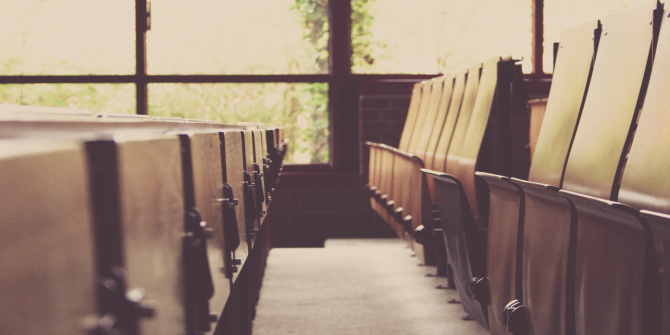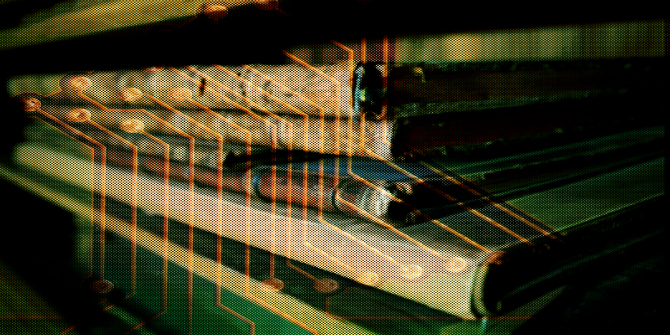Does it seem that education is somehow always lagging behind the latest technologies? In The Textbook and the Lecture: Education in the Age of New Media, Norm Friesen presents a longue durée study of the historical relationship between education and technologies of reading and writing in order to reframe accusations of ‘inertia’ in education. This is a useful introduction to a media history of education, finds Lavinia Marin, that offers insight for researchers and educational practitioners into the longstanding philosophical assumptions underpinning their teaching practice.
The Textbook and the Lecture: Education in the Age of New Media. Norm Friesen. Johns Hopkins University Press. 2017.
 Find this book (affiliate link):
Find this book (affiliate link): ![]()
‘Our educational system is outdated.’ Anyone following the news has stumbled upon this statement, be it on TV, radio or the internet. From the USA to India and Australia, a strange consensus unifies public opinion against one’s own educational system: namely, the perception that it is not up to the task. One important argument in this ongoing critique of education lies in the slow adoption of media technologies. It would appear that education is somehow always lagging behind the newest technologies: pupils were still writing by hand and reading paper-based textbooks while outside school walls computers were the norm; when computers entered classrooms, the outside world had already switched to laptops; when laptops finally landed on student’s desks, the world was turning to mobile phones and tablets. The race with technology seems to be already lost from the school side.
However, education’s slow adoption of emergent media technologies is not a new issue. On the contrary, as Norm Friesen shows in his latest book, The Textbook and the Lecture, educational resistance to new media has been occurring for centuries. Friesen’s book is concerned with the relation between media technologies and education, especially technologies of writing and reading. One of the book’s central arguments is that we cannot discuss education and its media separately as they always condition one another. Friesen argues that the most basic educational practices – learning to read, write and count – are actually operations of rewiring the brain. Education is, then, a commitment to this process through special media techniques such as reading and writing. However, this rewiring has a certain cultural history: it has acquired different significations throughout time. By looking at these, Friesen’s book helps its readers understand what is at stake in the current educational debates surrounding media.
The book is structured into three main parts. The first introduces the main theoretical approach of the book: namely, the focus on media as ‘an intermediate agency’ (13), a means which make possible for something else to be expressed or communicated. Media have three major features: they require literacies; give rise to their own cultures; and new media ‘remediate’ older media. Friesen argues that media are not just one way of acquiring knowledge, but the major way of doing so: ‘what we know […] is almost always mediated’ (14). The chapter also outlines the historical approach of the book as performing a history ‘over the longue durée’ of educational forms. Inspired by historian Fernand Braudel, this type of research studies slow changes and continuities instead of focusing on ruptures and revolutions, which are understood as being relatively rare events.
The second chapter offers an illustration of how to do history over the long duration by tracing writing instruction, the oldest education practice, over 4000 years of history. The history of education starts with the history of writing, and these two have been almost indistinguishable for long stretches of time. Text is the ‘most important for the culture of education’ (16) because education has writing at its centre, understood as a system of inscription. Passing on this system requires a lot of instruction and effort, because our brains are not naturally wired to learn how to write or to use inscriptions. Friesen reconstructs the history of education as the history of the effort to rewire the brain into learning to write and to use writing for thinking. The chapter compares ancient techniques of writing from Sumer, Jewish education and the Chinese imperial age with current writing practices. Friesen shows that writing instruction historically was standardised through repetitive exercises and dictation. Learning to write was about acquiring patterns of behaviour in designated spaces, separating pupils from the productive world and allocating for this a designated time: the time of the school. The similarity with current learning practices is striking. Friesen shows that children today ‘still learn writing through a set of steps with carefully sequenced arrangements of instructional methods, materials and content’ (29).
Friesen’s review of more than 4000 years of educational continuity is meant to reframe current accusations of ‘inertia’ in education. Critics of educational traditionalism are usually the proponents of novel methods and technologies that should bring education up to our current needs. But can we explain this educational continuity over thousands of years by calling it inertia? Could humanity have been so foolish as to maintain useless forms of education while it changed everything, from religion to political systems and social structures?
By using insights from neurology, Friesen proposes the hypothesis that the practices of reading and writing demand a rewiring of neurons in the brain. The commitment to the same educational forms for millennia has not been a commitment to tradition or to fixed values. Culturally speaking, reading and writing have served remarkably different purposes throughout history: for the small scribal class of ancient Sumer, reading and writing was related to book-keeping, advancing commerce and the first markets. Nowadays, reading and writing fulfil multiple purposes, keeping alive a culture and a form of life, cultivating imaginations and allowing for critical thinking. Yet pupils today learn to read and write with methods remarkably similar to those in ancient Sumer: repetitive exercises, dictations, rote memorisation, artificial problems and examples. Thus, the reformist demand to drop a certain medium from educational practices will understandably be met with scepticism. This commitment to the preservation of particular media in education – such as handwriting training in early grades, in spite of the possibility of replacing writing with typing – is a commitment not to the medium itself, but to the techniques which make a rewiring of the brain possible. It is through exercise and repetition, through the complex intermixing of speech and writing, looking and reading, that educational training techniques become most effective. We do not (yet) know how to achieve the same effects with digital technologies, perhaps because we are lacking centuries of experience from which to draw.
The third part illustrates these debates with the two case studies that give the title of the book – the textbook and the lecture. Friesen positions media as inextricably linked to education, while also pointing out that education has never been just about speech/orality nor writing/ literacy. Chapters Three to Five give an ample description of the debate between the proponents of speech and those of writing. Friesen shows how the speech/writing debate is at the core of many educational divisions between key figures in the history of education. Friesen traces the roots of contemporary debates to an old dualism between the partisans of education through speech (the Romantics, led by Jean-Jacques Rousseau, who saw spoken language as the natural, genuine language based on ‘expression and feeling’), and the Rationalists, led by John Amos Comenius, for whom Nature is like a book that one must learn to read or decipher. Rationalists also posit a universal language of nature, which led centuries later to Noam Chomsky’s universal grammar. While each tradition privileges one medium over the other, Friesen’s argument is that education is impossible with only one medium. Speech and writing have always been ‘inseparably intertwined’ in education (68).
One of the unanswered questions of the book is how this debate between speech and writing is reflected in the case of the university. If school is arguably about learning the basic habits of reading, writing and arithmetic, university is about something else. The last two chapters, Eight and Nine, focus on the university lecture, which is decidedly different from speaking to a classroom of pupils. Friesen points to reconceptualisations of the lecture from the medieval transmission of knowledge – mostly an oral enterprise – to Romantic and postmodern transformations. There was a clear Romantic perspective on the lecture, inspired by Johann Gottlieb Fichte and his follower Wilhelm von Humboldt, which attributes to it a certain communion of the spirits and an immediacy that cannot be achieved in the absence of speech. However, it is hard to find a Rationalist stance concerning the lecture. There is a difficulty here in connecting the lecture chapters to the rest of the book because university education seems to be about something other than a rewiring of the brain. What the university or any other forms of complex education do with the brain is therefore a question left open by this book.
One can also question the entire ‘neurological explanation’ angle that the book adopts. Indeed, neurology offers a nice explanation of why education prefers certain well-tested methods to newer approaches, but in the current philosophy of education there is a heated debate about the explanatory power of neurological insights and there are concerns that the ‘neurological turn’ might be another form of revived scientism, a debate left unaddressed by Friesen. Even if we accept this neurological angle, in the end the book does not help us take a stance on the ‘digital revolution’ sweeping schools and universities. In the general debate between speech and writing, digital technologies seem to lie on the side of speech, with their promise of instant access akin to unmediated immediacy. On the other hand, digital technologies do involve a lot of writing and are based on coding. Our conceptualisation of the digital is culturally determined just as much as previous technologies. While Friesen does not set out to answer the digital question, but rather to subvert or dissolve it via historical contextualisation, we are still left with a quandary: what do we do with digital technologies in education? The book’s greatest strength is that it makes us reflect on the historicity of technological discourse in education, but this turns into a weakness once we arrive at the moment of taking a concrete step.
The Textbook and the Lecture addresses both a general and a specialised audience. The latter consists of educational theorists and philosophers, especially those working around educational media, who will be interested in the theoretical intervention of the book. For practitioners, it opens up the black box of educational practices by showing why they may still be using ‘outdated’ media in their classrooms. For any member of the general public who might feel tempted to get sucked into the debate about the outmoded nature of educational forms and methods, policymakers and other stakeholders such as parents, educational workers and school managers, this book offers a good introduction to a media history of education. Through its multiple examples and case studies, The Textbook and the Lecture shows the philosophical assumptions underpinning longstanding debates and serves to inform and perhaps even empower educational workers by helping them understand why they do what they do.
Note: This review gives the views of the author, and not the position of the LSE Review of Books blog, or of the London School of Economics. The LSE RB blog may receive a small commission if you choose to make a purchase through the above Amazon affiliate link. This is entirely independent of the coverage of the book on LSE Review of Books.
Image Credit: (Markus Spiske CC BY 2.0).









2 Comments